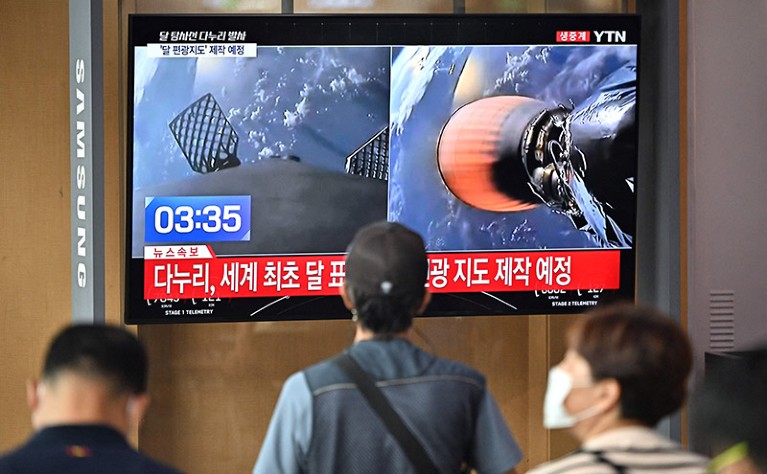South Korea’s lunar mission, known as Danuri, launched in August 2022.Credit: Jung Yeon-je/AFP via Getty
South Korea’s first lunar mission has revealed surprising information about the far side of the Moon, among a host of other insights, scientists reported this week at the American Geophysical Union meeting in San Francisco, California. The mission, known as the Korea Pathfinder Lunar Orbiter, nicknamed Danuri, launched in August 2022 and has been studying the Moon since beginning its orbit in December of that year.
“Everything is beyond our expectations, actually,” says Eunhyeuk Kim, the science team leader for the mission at the Korea Aerospace Research Institute in Daejeon, South Korea.
Danuri is the first South Korean spacecraft to travel beyond Earth’s orbit. It is meant to pave the way for South Korean astronauts to visit the lunar surface in the coming decades. Mission scientists are working with NASA and other space agencies to pursue that goal.
Among the observations reported at the meeting were the results of the gamma-ray spectrometer aboard Danuri. This instrument measures high-energy electromagnetic radiation coming from the lunar surface, which can reveal the chemical make-up of the minerals there. But from its vantage point orbiting the Moon, it also detected gamma rays from elsewhere in space, said Kyeong ja Kim, a planetary scientist at the Korea Institute of Geoscience and Mineral Resources in Daejeon. That includes the brightest burst of gamma rays ever detected — an enormous blast from a galaxy 580 million parsecs (1.9 billion light years) away that washed over Earth in October 2022. Danuri also measured dozens of other gamma-ray bursts coming from distant stars, as well as spikes in radiation created by storms on the Sun.
A NASA camera aboard Danuri is providing some of the best glimpses yet into craters near the Moon’s poles, where the Sun’s rays cannot reach. This ‘ShadowCam’ can pick up the small amounts of light scattered from nearby better-lit areas. It revealed that some craters near the Moon’s equator, when seen in oblique lighting, were not as pronounced as they appeared to be in photographs from less-sensitive cameras, reported Emerson Speyerer, a planetary scientist at Arizona State University in Tempe. Comparing craters near the Moon’s poles with those closer to the equator when both are under similar lighting conditions could allow researchers to better interpret the pictures from the poorly-understood poles.
“It doesn’t make sense”
Perhaps the most baffling of Danuri’s measurements was of the magnetic fields on the Moon’s far side. Working in concert with two small NASA lunar satellites in ways that have not been done before, Danuri was able to measure magnetic fields generated by the Moon’s electrically conducting interior, said Wooin Jo, a planetary scientist at Kyung Hee University in Yongin, South Korea. According to the measurements, the far side of the Moon seems to be more electrically conductive than the near side, “which doesn’t make sense”, says Ian Garrick-Bethell, a planetary scientist at the University of California, Santa Cruz. Higher electrical conductivity implies that the far side of the Moon is hotter, or perhaps contains more water in its interior than the near side, but why one side of the Moon seems to be different from the other is something that scientists can’t currently explain.
Just one of Danuri’s flagship instruments is struggling. There are two cameras designed to observe the lunar surface in polarized light, which can reveal more information than can be seen under ordinary light. But the primary polarized camera is taking measurements much slower than anticipated. Processing the images is also proving difficult, Sung-Soo Kim, an astronomer at Kyung Hee University told the conference. Smears and other artifacts mar many of the images, requiring lots of time to process them and extract scientific information.
But the mission scientists are overall satisfied with Danuri’s achievements. The spacecraft has already lasted longer than its anticipated one-year lifetime, and could operate for months or even years longer. One big question is whether the spacecraft will be able to survive a solar eclipse, set to happen in March 2025, which will cut off sunlight and force it to rely on its batteries, says Eunhyeuk Kim. If it does survive, the mission controllers will have the luxury of deciding how long to keep operating the mission. “There might be a lot of choices to make,” he says.
